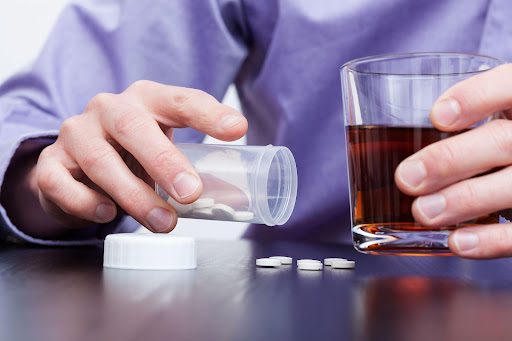Nearly 7.7 million adults in the United States are affected by co-occurring mental health and substance addictions, and teasing apart both conditions can be difficult. And while treatment can be effective, many individuals do not seek treatment due to costs and not feeling ready to stop using substances. This raises the question: Is addiction a mental health issue, or is it the other way around? How does addiction affect mental health? The answers to these questions are complex, in that both conditions often develop together, and impact each other. As research explores the intersections between biology and psychology, the study of these disorders becomes clearer.
Read on to learn what dual diagnosis is and why mental health and addiction issues occur together. Then review common dual diagnosis conditions. Finally, understand the options for dual diagnosis treatment.

Dual diagnosis refers to the development of mental health conditions and addiction to illicit substances (i.e. drugs) at the same time. While both types of disorders can develop on their own, they often occur together.
Common risk factors and symptom exacerbation play large roles in the co-occurrence of mental health issues and addiction. Researchers continue to explore these connections and learn how disorders develop together.
Common Risk Factors
Many mental health and substance use disorders share similar risk factors. This does not mean a specific risk factor directly causes these conditions to occur, nor does one condition necessarily lead to the development of another. However, common risk factors can make individuals vulnerable to developing mental disorders, addiction, or both simultaneously. Common risk factors for these disorders include genetics, exposure to trauma, environmental influences, stress, and the irregular structure or activity of specific brain regions.
The prevalence of dual diagnosis can be gleaned through cases of early-life trauma, with research showing that individuals who had lived through trauma as children tend to develop mental health disorders (such as depression and PTSD), as well as alcohol addiction, at a significantly higher rate. Dual diagnosis has also been found to run in families, highlighting the potential impact of both genetic and environmental influences on mental health and addiction.
Exacerbation of Both Conditions
Mental health conditions and substance use disorder can exacerbate one another, often leading to worse outcomes over time than for either one alone. For example, individuals with significant mental health conditions may self-medicate, using substances to feel better or cover their symptoms.
While substance misuse may seem like a short-term solution, it amplifies symptoms. This can worsen mental health conditions and set the stage for additional substance use problems. Prolonged substance use can also change brain functioning, making emotional regulation more difficult, and increasing the risk of mental disorders.
Dual diagnosis can occur with any misused substance, both legal and illicit. While dual diagnosis can occur with any mental condition, the association is strongest with serious mental illness (SMI), conditions severe enough to cause functional impairment and disruption of major life activities, such as school and work. These include post-traumatic stress disorder (PTSD), major depression, schizophrenia, and bipolar disorder.
PTSD can occur following exposure to highly upsetting events, such as war, abuse, severe accidents, and natural disasters. Individuals develop an exaggerated fear response that can present itself through the following types of symptoms.
The detrimental symptoms of PTSD can lead those facing the disorder to self-medicate. In fact, a study from 2020 found that 46% of those with PTSD also develop a substance use disorder. It was additionally shown that individuals with PTSD who self-medicate often lean toward harder drugs, such as opioids and cocaine.
Major depression is a mood disorder causing persistent sadness, loss of interest in pleasurable activities, and other distressing symptoms interfering with daily activities, for at least two weeks. These include:
Major depression and addiction are highly correlated, with as many as 25% of individuals facing depression also developing a substance use disorder. Alcohol is the most misused substance, at 20%, followed by 12% for illicit substances (methamphetamines, cocaine, and MDMA), 12% for cannabis, and 4% for inhalants.
Schizophrenia is a debilitating mental health disorder, in which individuals struggle with an irrational perception of reality, as well as paranoid delusions and beliefs.

Evidence suggests that schizophrenia and substance use disorders may have a bidirectional relationship, so that the development of one condition may prompt the emergence of the other. Studies show that as many as 75% of individuals with schizophrenia use substances, with up to 47% developing a substance use disorder. The most commonly used substances include tobacco, cannabis, alcohol, and cocaine.
Bipolar disorders are conditions with episodes of mania, a mood state marked by extreme excitability and a sharply elevated mood.
Many individuals also experience shifts between depression and mania, disrupting daily activities and functioning.
The lifetime prevalence for substance use disorders among those with bipolar disorders is 35-50%, with alcohol being the most frequently misused substance (42%), followed by cannabis (20%), and other illicit substances (11%), such as opiates and cocaine.
Some psychiatric conditions resemble addictions but are not technically diagnosable as such because no chemicals are introduced into the body. These behavioral or process addictions are commonly known as gaming or internet addiction. Mental health is typically poorer overall for individuals with these issues, such as the emergence of depression, interpersonal sensitivity, anxiety, and other distressing symptoms.
Treatment for mental health issues and addiction is most effective when implemented simultaneously. The bidirectional interactions between disorders can be addressed, leading to more comprehensive care and better health outcomes. Treatment programs are available at three levels of care according to symptom severity and impact on functioning. Depending on their needs and specific diagnoses, Individuals may utilize more than one type of dual diagnosis treatment program throughout their recovery.
Outpatient treatment is the least intensive level of care, providing therapy and support via flexible scheduling to work around jobs, school, and family responsibilities. These programs are widely available in many communities, providing affordable care with minimal disruption of daily routines. Aftercare programs are the least intrusive and offer ongoing contact as individuals maintain recovery.
In residential treatment programs, individuals stay in a home-like residential facility for several weeks or months, participating in therapeutic programs and adjusting to substance-free life changes. This level of care is recommended for individuals with more severe symptoms or complex diagnoses and may include medically supervised substance detoxification. Support is available at all times, but individuals also have some autonomy and free time.
Inpatient care is the most intensive form of treatment, usually done in a 24-hour care setting, such as a hospital. Individuals may require medically supervised detoxification from substances and may also have vulnerable health conditions requiring round-the-clock care. This is the most restrictive level of care, and the primary goal is to achieve medical stability so individuals may progress to lower levels of therapeutic care.
Managing dual diagnosis conditions can be challenging, but treatment programs can support individuals as they move through all phases of recovery. And because these conditions often persist throughout an individual’s lifetime, individuals may go through treatment multiple times. Improved awareness and understanding of dual diagnosis disorders can help those affected as they navigate their recovery.